Section 1: Design Issues for Millennium Mills Redevelopment
VerifiedAdded on 2023/01/12
|15
|4662
|96
Report
AI Summary
This report, focusing on the design issues of a construction project, delves into the critical aspects of project planning and execution. It begins with an introduction to project design and its significance in guiding a business toward successful completion. The report then outlines a detailed Gantt chart, adhering to the RIBA plan of works, to illustrate time constraints prior to construction, specifically for the redevelopment of Millennium Mills. The report also provides a financial analysis to justify the cost implications at the design stage. Furthermore, it discusses the application of Building Information Modelling (BIM) to the project. The report is structured to provide a clear understanding of the design process, from strategic definition to handover, including the importance of sustainability, client visualization, and regulatory approvals. It emphasizes the need for effective project management, especially in construction businesses facing design-related challenges. The report concludes by summarizing the key findings and implications for project success, offering insights into the various stages of a construction project and the tools required to manage them effectively.
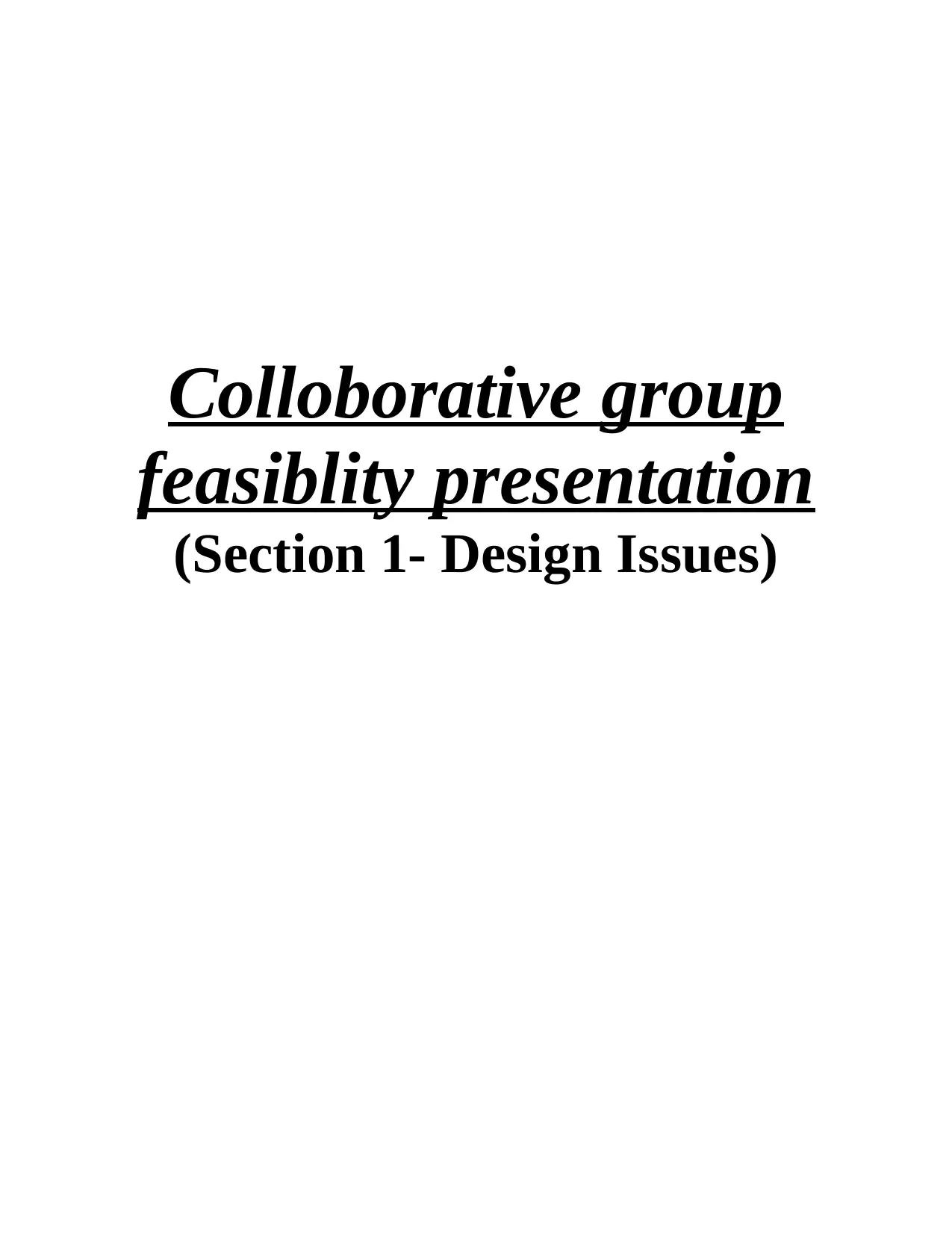
Colloborative group
feasiblity presentation
(Section 1- Design Issues)
feasiblity presentation
(Section 1- Design Issues)
Paraphrase This Document
Need a fresh take? Get an instant paraphrase of this document with our AI Paraphraser
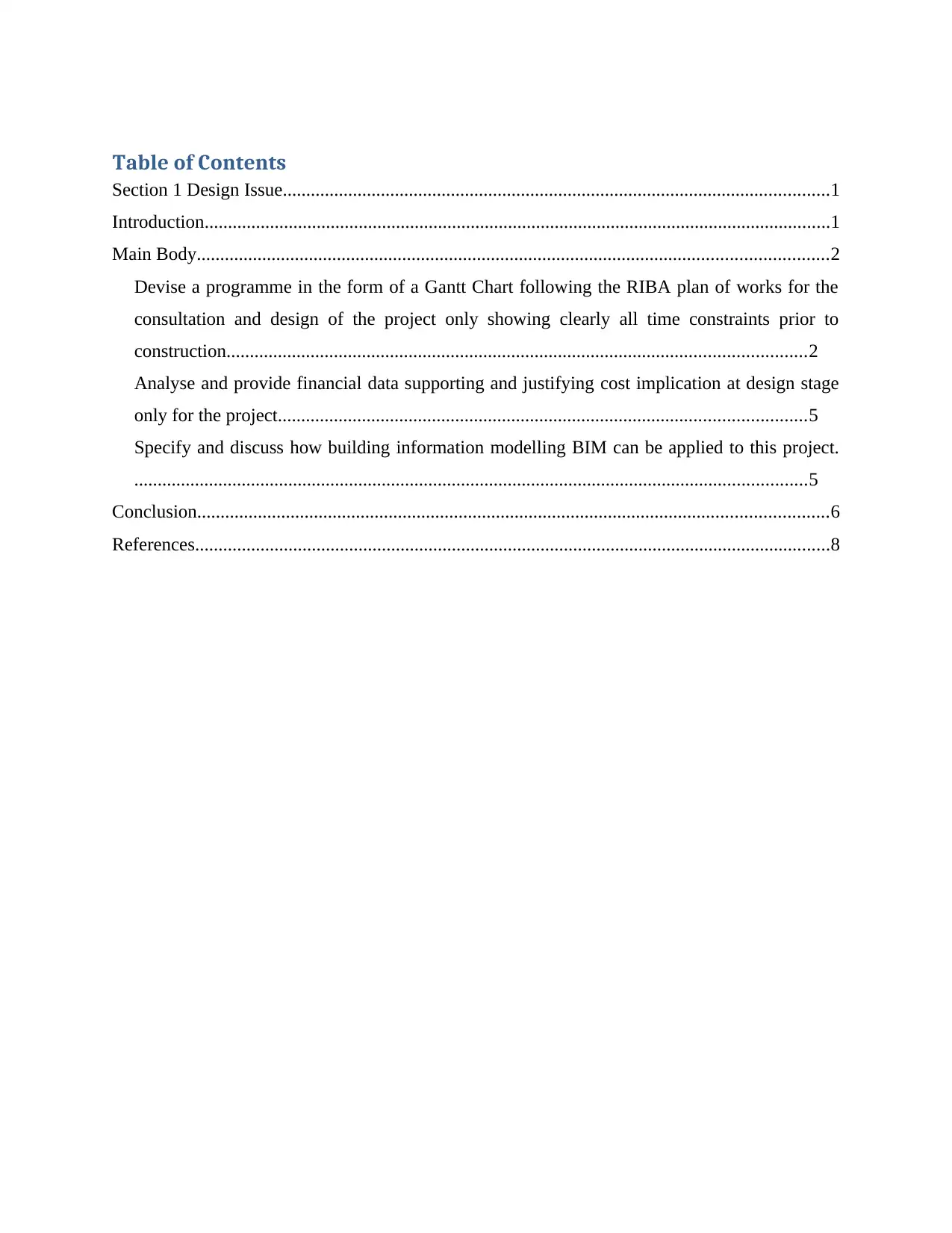
Table of Contents
Section 1 Design Issue.....................................................................................................................1
Introduction......................................................................................................................................1
Main Body.......................................................................................................................................2
Devise a programme in the form of a Gantt Chart following the RIBA plan of works for the
consultation and design of the project only showing clearly all time constraints prior to
construction............................................................................................................................2
Analyse and provide financial data supporting and justifying cost implication at design stage
only for the project.................................................................................................................5
Specify and discuss how building information modelling BIM can be applied to this project.
................................................................................................................................................5
Conclusion.......................................................................................................................................6
References........................................................................................................................................8
Section 1 Design Issue.....................................................................................................................1
Introduction......................................................................................................................................1
Main Body.......................................................................................................................................2
Devise a programme in the form of a Gantt Chart following the RIBA plan of works for the
consultation and design of the project only showing clearly all time constraints prior to
construction............................................................................................................................2
Analyse and provide financial data supporting and justifying cost implication at design stage
only for the project.................................................................................................................5
Specify and discuss how building information modelling BIM can be applied to this project.
................................................................................................................................................5
Conclusion.......................................................................................................................................6
References........................................................................................................................................8

⊘ This is a preview!⊘
Do you want full access?
Subscribe today to unlock all pages.

Trusted by 1+ million students worldwide
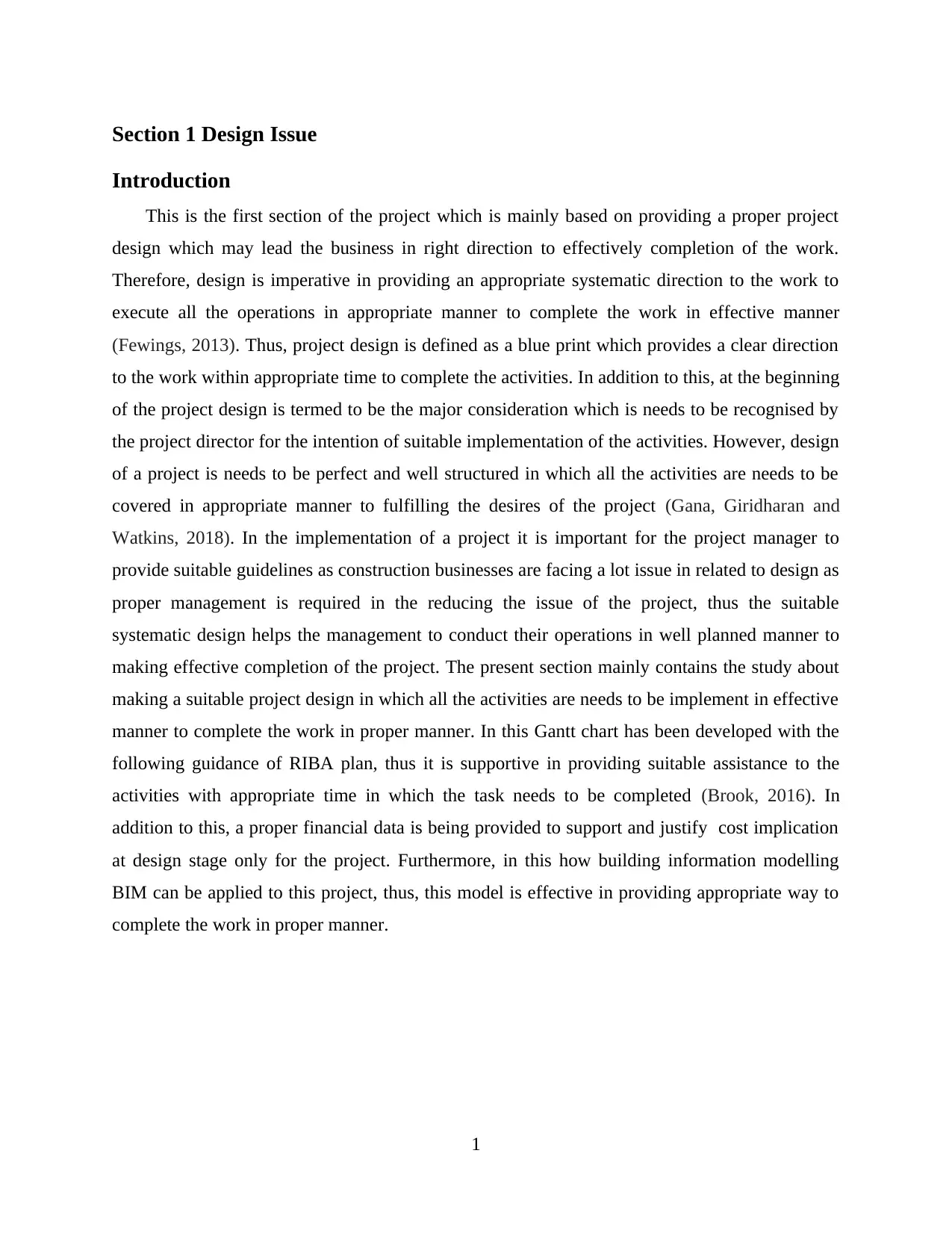
Section 1 Design Issue
Introduction
This is the first section of the project which is mainly based on providing a proper project
design which may lead the business in right direction to effectively completion of the work.
Therefore, design is imperative in providing an appropriate systematic direction to the work to
execute all the operations in appropriate manner to complete the work in effective manner
(Fewings, 2013). Thus, project design is defined as a blue print which provides a clear direction
to the work within appropriate time to complete the activities. In addition to this, at the beginning
of the project design is termed to be the major consideration which is needs to be recognised by
the project director for the intention of suitable implementation of the activities. However, design
of a project is needs to be perfect and well structured in which all the activities are needs to be
covered in appropriate manner to fulfilling the desires of the project (Gana, Giridharan and
Watkins, 2018). In the implementation of a project it is important for the project manager to
provide suitable guidelines as construction businesses are facing a lot issue in related to design as
proper management is required in the reducing the issue of the project, thus the suitable
systematic design helps the management to conduct their operations in well planned manner to
making effective completion of the project. The present section mainly contains the study about
making a suitable project design in which all the activities are needs to be implement in effective
manner to complete the work in proper manner. In this Gantt chart has been developed with the
following guidance of RIBA plan, thus it is supportive in providing suitable assistance to the
activities with appropriate time in which the task needs to be completed (Brook, 2016). In
addition to this, a proper financial data is being provided to support and justify cost implication
at design stage only for the project. Furthermore, in this how building information modelling
BIM can be applied to this project, thus, this model is effective in providing appropriate way to
complete the work in proper manner.
1
Introduction
This is the first section of the project which is mainly based on providing a proper project
design which may lead the business in right direction to effectively completion of the work.
Therefore, design is imperative in providing an appropriate systematic direction to the work to
execute all the operations in appropriate manner to complete the work in effective manner
(Fewings, 2013). Thus, project design is defined as a blue print which provides a clear direction
to the work within appropriate time to complete the activities. In addition to this, at the beginning
of the project design is termed to be the major consideration which is needs to be recognised by
the project director for the intention of suitable implementation of the activities. However, design
of a project is needs to be perfect and well structured in which all the activities are needs to be
covered in appropriate manner to fulfilling the desires of the project (Gana, Giridharan and
Watkins, 2018). In the implementation of a project it is important for the project manager to
provide suitable guidelines as construction businesses are facing a lot issue in related to design as
proper management is required in the reducing the issue of the project, thus the suitable
systematic design helps the management to conduct their operations in well planned manner to
making effective completion of the project. The present section mainly contains the study about
making a suitable project design in which all the activities are needs to be implement in effective
manner to complete the work in proper manner. In this Gantt chart has been developed with the
following guidance of RIBA plan, thus it is supportive in providing suitable assistance to the
activities with appropriate time in which the task needs to be completed (Brook, 2016). In
addition to this, a proper financial data is being provided to support and justify cost implication
at design stage only for the project. Furthermore, in this how building information modelling
BIM can be applied to this project, thus, this model is effective in providing appropriate way to
complete the work in proper manner.
1
Paraphrase This Document
Need a fresh take? Get an instant paraphrase of this document with our AI Paraphraser
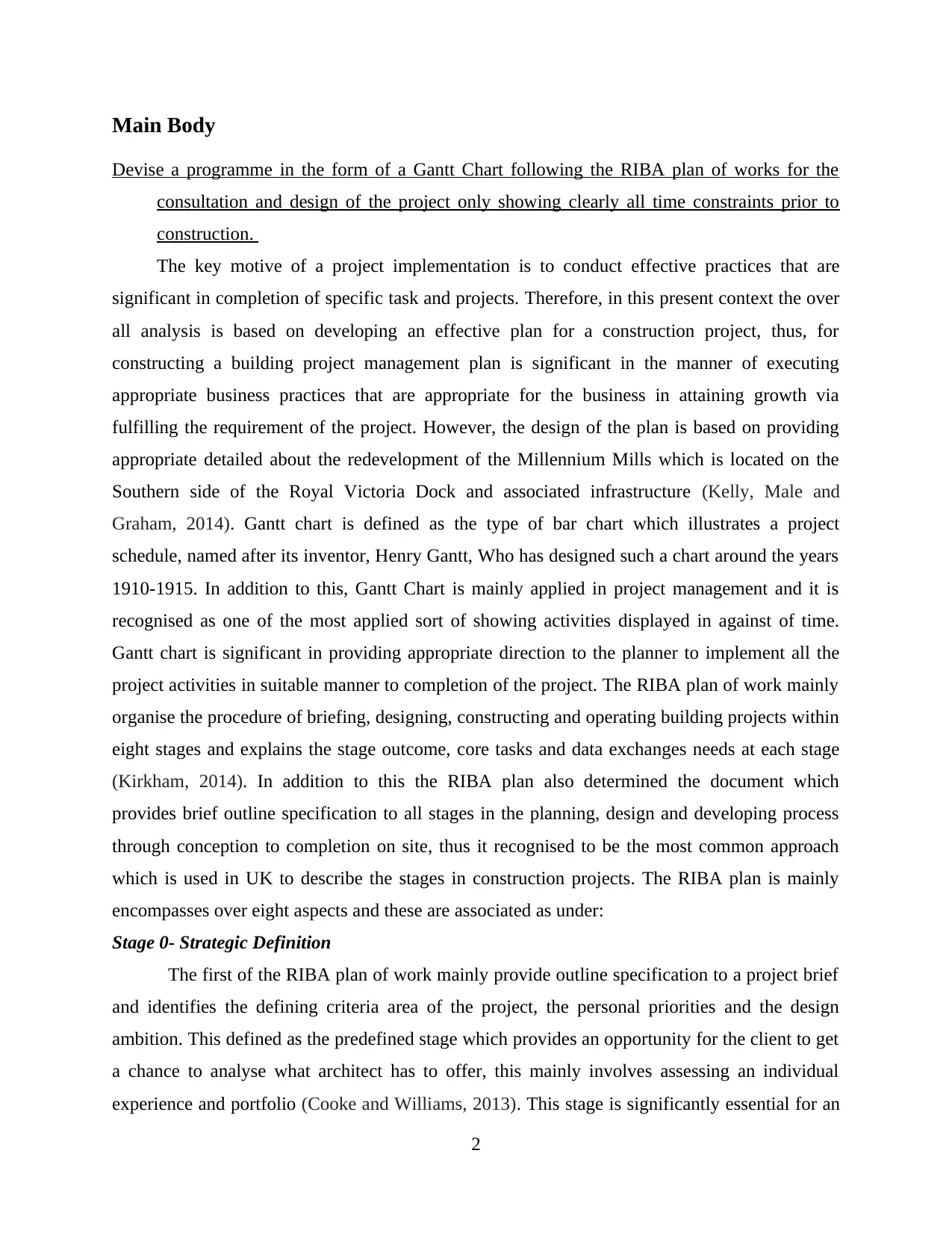
Main Body
Devise a programme in the form of a Gantt Chart following the RIBA plan of works for the
consultation and design of the project only showing clearly all time constraints prior to
construction.
The key motive of a project implementation is to conduct effective practices that are
significant in completion of specific task and projects. Therefore, in this present context the over
all analysis is based on developing an effective plan for a construction project, thus, for
constructing a building project management plan is significant in the manner of executing
appropriate business practices that are appropriate for the business in attaining growth via
fulfilling the requirement of the project. However, the design of the plan is based on providing
appropriate detailed about the redevelopment of the Millennium Mills which is located on the
Southern side of the Royal Victoria Dock and associated infrastructure (Kelly, Male and
Graham, 2014). Gantt chart is defined as the type of bar chart which illustrates a project
schedule, named after its inventor, Henry Gantt, Who has designed such a chart around the years
1910-1915. In addition to this, Gantt Chart is mainly applied in project management and it is
recognised as one of the most applied sort of showing activities displayed in against of time.
Gantt chart is significant in providing appropriate direction to the planner to implement all the
project activities in suitable manner to completion of the project. The RIBA plan of work mainly
organise the procedure of briefing, designing, constructing and operating building projects within
eight stages and explains the stage outcome, core tasks and data exchanges needs at each stage
(Kirkham, 2014). In addition to this the RIBA plan also determined the document which
provides brief outline specification to all stages in the planning, design and developing process
through conception to completion on site, thus it recognised to be the most common approach
which is used in UK to describe the stages in construction projects. The RIBA plan is mainly
encompasses over eight aspects and these are associated as under:
Stage 0- Strategic Definition
The first of the RIBA plan of work mainly provide outline specification to a project brief
and identifies the defining criteria area of the project, the personal priorities and the design
ambition. This defined as the predefined stage which provides an opportunity for the client to get
a chance to analyse what architect has to offer, this mainly involves assessing an individual
experience and portfolio (Cooke and Williams, 2013). This stage is significantly essential for an
2
Devise a programme in the form of a Gantt Chart following the RIBA plan of works for the
consultation and design of the project only showing clearly all time constraints prior to
construction.
The key motive of a project implementation is to conduct effective practices that are
significant in completion of specific task and projects. Therefore, in this present context the over
all analysis is based on developing an effective plan for a construction project, thus, for
constructing a building project management plan is significant in the manner of executing
appropriate business practices that are appropriate for the business in attaining growth via
fulfilling the requirement of the project. However, the design of the plan is based on providing
appropriate detailed about the redevelopment of the Millennium Mills which is located on the
Southern side of the Royal Victoria Dock and associated infrastructure (Kelly, Male and
Graham, 2014). Gantt chart is defined as the type of bar chart which illustrates a project
schedule, named after its inventor, Henry Gantt, Who has designed such a chart around the years
1910-1915. In addition to this, Gantt Chart is mainly applied in project management and it is
recognised as one of the most applied sort of showing activities displayed in against of time.
Gantt chart is significant in providing appropriate direction to the planner to implement all the
project activities in suitable manner to completion of the project. The RIBA plan of work mainly
organise the procedure of briefing, designing, constructing and operating building projects within
eight stages and explains the stage outcome, core tasks and data exchanges needs at each stage
(Kirkham, 2014). In addition to this the RIBA plan also determined the document which
provides brief outline specification to all stages in the planning, design and developing process
through conception to completion on site, thus it recognised to be the most common approach
which is used in UK to describe the stages in construction projects. The RIBA plan is mainly
encompasses over eight aspects and these are associated as under:
Stage 0- Strategic Definition
The first of the RIBA plan of work mainly provide outline specification to a project brief
and identifies the defining criteria area of the project, the personal priorities and the design
ambition. This defined as the predefined stage which provides an opportunity for the client to get
a chance to analyse what architect has to offer, this mainly involves assessing an individual
experience and portfolio (Cooke and Williams, 2013). This stage is significantly essential for an
2
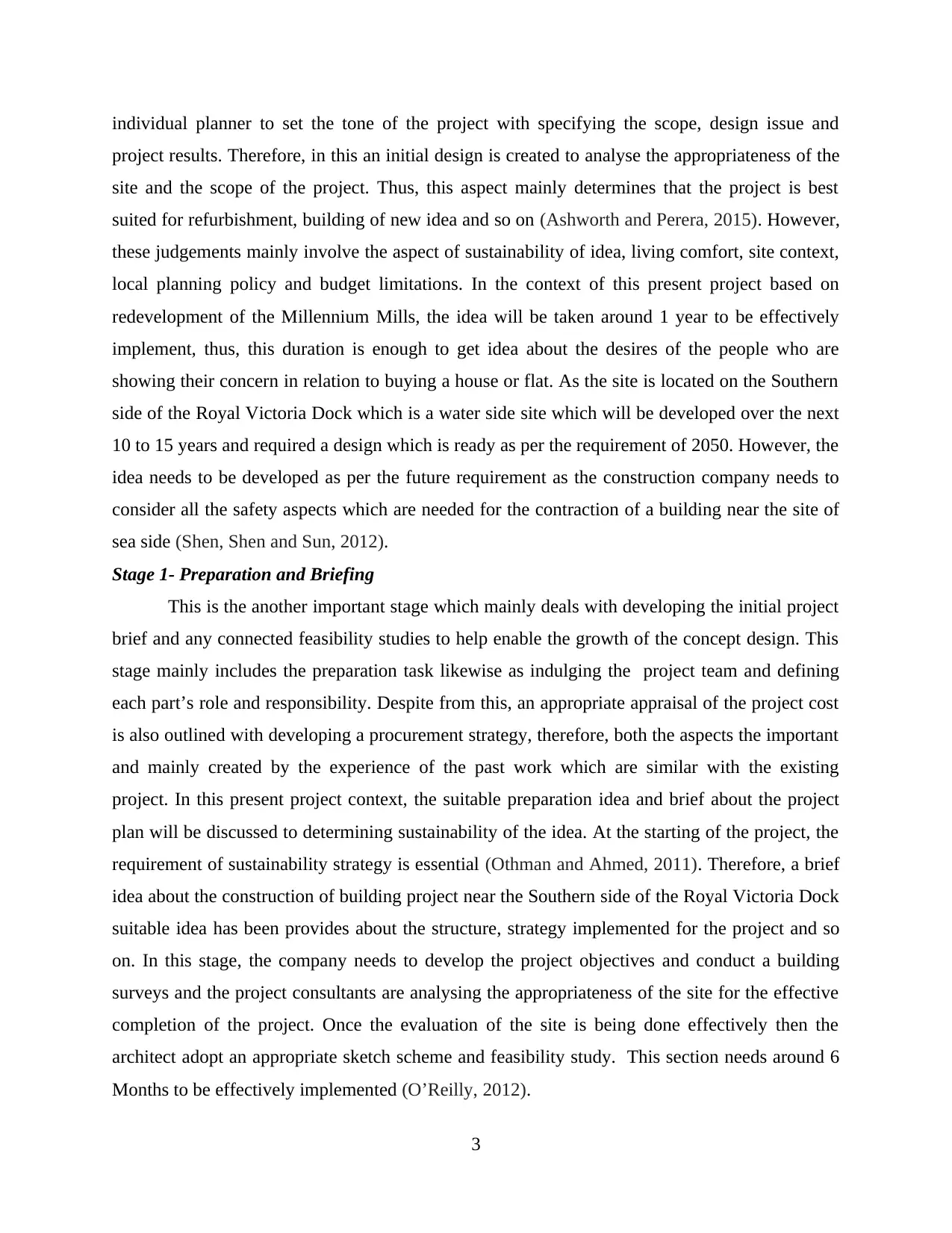
individual planner to set the tone of the project with specifying the scope, design issue and
project results. Therefore, in this an initial design is created to analyse the appropriateness of the
site and the scope of the project. Thus, this aspect mainly determines that the project is best
suited for refurbishment, building of new idea and so on (Ashworth and Perera, 2015). However,
these judgements mainly involve the aspect of sustainability of idea, living comfort, site context,
local planning policy and budget limitations. In the context of this present project based on
redevelopment of the Millennium Mills, the idea will be taken around 1 year to be effectively
implement, thus, this duration is enough to get idea about the desires of the people who are
showing their concern in relation to buying a house or flat. As the site is located on the Southern
side of the Royal Victoria Dock which is a water side site which will be developed over the next
10 to 15 years and required a design which is ready as per the requirement of 2050. However, the
idea needs to be developed as per the future requirement as the construction company needs to
consider all the safety aspects which are needed for the contraction of a building near the site of
sea side (Shen, Shen and Sun, 2012).
Stage 1- Preparation and Briefing
This is the another important stage which mainly deals with developing the initial project
brief and any connected feasibility studies to help enable the growth of the concept design. This
stage mainly includes the preparation task likewise as indulging the project team and defining
each part’s role and responsibility. Despite from this, an appropriate appraisal of the project cost
is also outlined with developing a procurement strategy, therefore, both the aspects the important
and mainly created by the experience of the past work which are similar with the existing
project. In this present project context, the suitable preparation idea and brief about the project
plan will be discussed to determining sustainability of the idea. At the starting of the project, the
requirement of sustainability strategy is essential (Othman and Ahmed, 2011). Therefore, a brief
idea about the construction of building project near the Southern side of the Royal Victoria Dock
suitable idea has been provides about the structure, strategy implemented for the project and so
on. In this stage, the company needs to develop the project objectives and conduct a building
surveys and the project consultants are analysing the appropriateness of the site for the effective
completion of the project. Once the evaluation of the site is being done effectively then the
architect adopt an appropriate sketch scheme and feasibility study. This section needs around 6
Months to be effectively implemented (O’Reilly, 2012).
3
project results. Therefore, in this an initial design is created to analyse the appropriateness of the
site and the scope of the project. Thus, this aspect mainly determines that the project is best
suited for refurbishment, building of new idea and so on (Ashworth and Perera, 2015). However,
these judgements mainly involve the aspect of sustainability of idea, living comfort, site context,
local planning policy and budget limitations. In the context of this present project based on
redevelopment of the Millennium Mills, the idea will be taken around 1 year to be effectively
implement, thus, this duration is enough to get idea about the desires of the people who are
showing their concern in relation to buying a house or flat. As the site is located on the Southern
side of the Royal Victoria Dock which is a water side site which will be developed over the next
10 to 15 years and required a design which is ready as per the requirement of 2050. However, the
idea needs to be developed as per the future requirement as the construction company needs to
consider all the safety aspects which are needed for the contraction of a building near the site of
sea side (Shen, Shen and Sun, 2012).
Stage 1- Preparation and Briefing
This is the another important stage which mainly deals with developing the initial project
brief and any connected feasibility studies to help enable the growth of the concept design. This
stage mainly includes the preparation task likewise as indulging the project team and defining
each part’s role and responsibility. Despite from this, an appropriate appraisal of the project cost
is also outlined with developing a procurement strategy, therefore, both the aspects the important
and mainly created by the experience of the past work which are similar with the existing
project. In this present project context, the suitable preparation idea and brief about the project
plan will be discussed to determining sustainability of the idea. At the starting of the project, the
requirement of sustainability strategy is essential (Othman and Ahmed, 2011). Therefore, a brief
idea about the construction of building project near the Southern side of the Royal Victoria Dock
suitable idea has been provides about the structure, strategy implemented for the project and so
on. In this stage, the company needs to develop the project objectives and conduct a building
surveys and the project consultants are analysing the appropriateness of the site for the effective
completion of the project. Once the evaluation of the site is being done effectively then the
architect adopt an appropriate sketch scheme and feasibility study. This section needs around 6
Months to be effectively implemented (O’Reilly, 2012).
3
⊘ This is a preview!⊘
Do you want full access?
Subscribe today to unlock all pages.

Trusted by 1+ million students worldwide
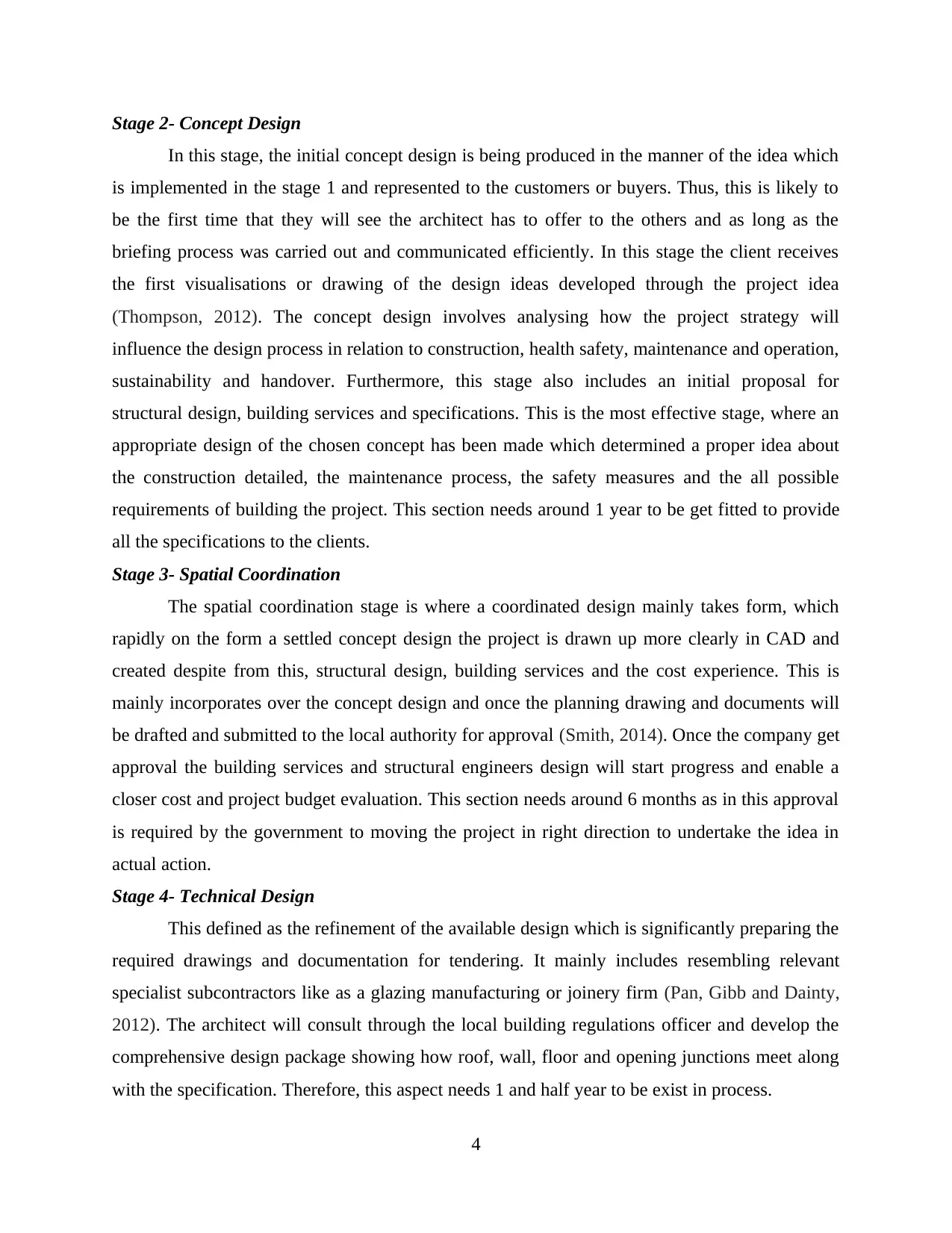
Stage 2- Concept Design
In this stage, the initial concept design is being produced in the manner of the idea which
is implemented in the stage 1 and represented to the customers or buyers. Thus, this is likely to
be the first time that they will see the architect has to offer to the others and as long as the
briefing process was carried out and communicated efficiently. In this stage the client receives
the first visualisations or drawing of the design ideas developed through the project idea
(Thompson, 2012). The concept design involves analysing how the project strategy will
influence the design process in relation to construction, health safety, maintenance and operation,
sustainability and handover. Furthermore, this stage also includes an initial proposal for
structural design, building services and specifications. This is the most effective stage, where an
appropriate design of the chosen concept has been made which determined a proper idea about
the construction detailed, the maintenance process, the safety measures and the all possible
requirements of building the project. This section needs around 1 year to be get fitted to provide
all the specifications to the clients.
Stage 3- Spatial Coordination
The spatial coordination stage is where a coordinated design mainly takes form, which
rapidly on the form a settled concept design the project is drawn up more clearly in CAD and
created despite from this, structural design, building services and the cost experience. This is
mainly incorporates over the concept design and once the planning drawing and documents will
be drafted and submitted to the local authority for approval (Smith, 2014). Once the company get
approval the building services and structural engineers design will start progress and enable a
closer cost and project budget evaluation. This section needs around 6 months as in this approval
is required by the government to moving the project in right direction to undertake the idea in
actual action.
Stage 4- Technical Design
This defined as the refinement of the available design which is significantly preparing the
required drawings and documentation for tendering. It mainly includes resembling relevant
specialist subcontractors like as a glazing manufacturing or joinery firm (Pan, Gibb and Dainty,
2012). The architect will consult through the local building regulations officer and develop the
comprehensive design package showing how roof, wall, floor and opening junctions meet along
with the specification. Therefore, this aspect needs 1 and half year to be exist in process.
4
In this stage, the initial concept design is being produced in the manner of the idea which
is implemented in the stage 1 and represented to the customers or buyers. Thus, this is likely to
be the first time that they will see the architect has to offer to the others and as long as the
briefing process was carried out and communicated efficiently. In this stage the client receives
the first visualisations or drawing of the design ideas developed through the project idea
(Thompson, 2012). The concept design involves analysing how the project strategy will
influence the design process in relation to construction, health safety, maintenance and operation,
sustainability and handover. Furthermore, this stage also includes an initial proposal for
structural design, building services and specifications. This is the most effective stage, where an
appropriate design of the chosen concept has been made which determined a proper idea about
the construction detailed, the maintenance process, the safety measures and the all possible
requirements of building the project. This section needs around 1 year to be get fitted to provide
all the specifications to the clients.
Stage 3- Spatial Coordination
The spatial coordination stage is where a coordinated design mainly takes form, which
rapidly on the form a settled concept design the project is drawn up more clearly in CAD and
created despite from this, structural design, building services and the cost experience. This is
mainly incorporates over the concept design and once the planning drawing and documents will
be drafted and submitted to the local authority for approval (Smith, 2014). Once the company get
approval the building services and structural engineers design will start progress and enable a
closer cost and project budget evaluation. This section needs around 6 months as in this approval
is required by the government to moving the project in right direction to undertake the idea in
actual action.
Stage 4- Technical Design
This defined as the refinement of the available design which is significantly preparing the
required drawings and documentation for tendering. It mainly includes resembling relevant
specialist subcontractors like as a glazing manufacturing or joinery firm (Pan, Gibb and Dainty,
2012). The architect will consult through the local building regulations officer and develop the
comprehensive design package showing how roof, wall, floor and opening junctions meet along
with the specification. Therefore, this aspect needs 1 and half year to be exist in process.
4
Paraphrase This Document
Need a fresh take? Get an instant paraphrase of this document with our AI Paraphraser
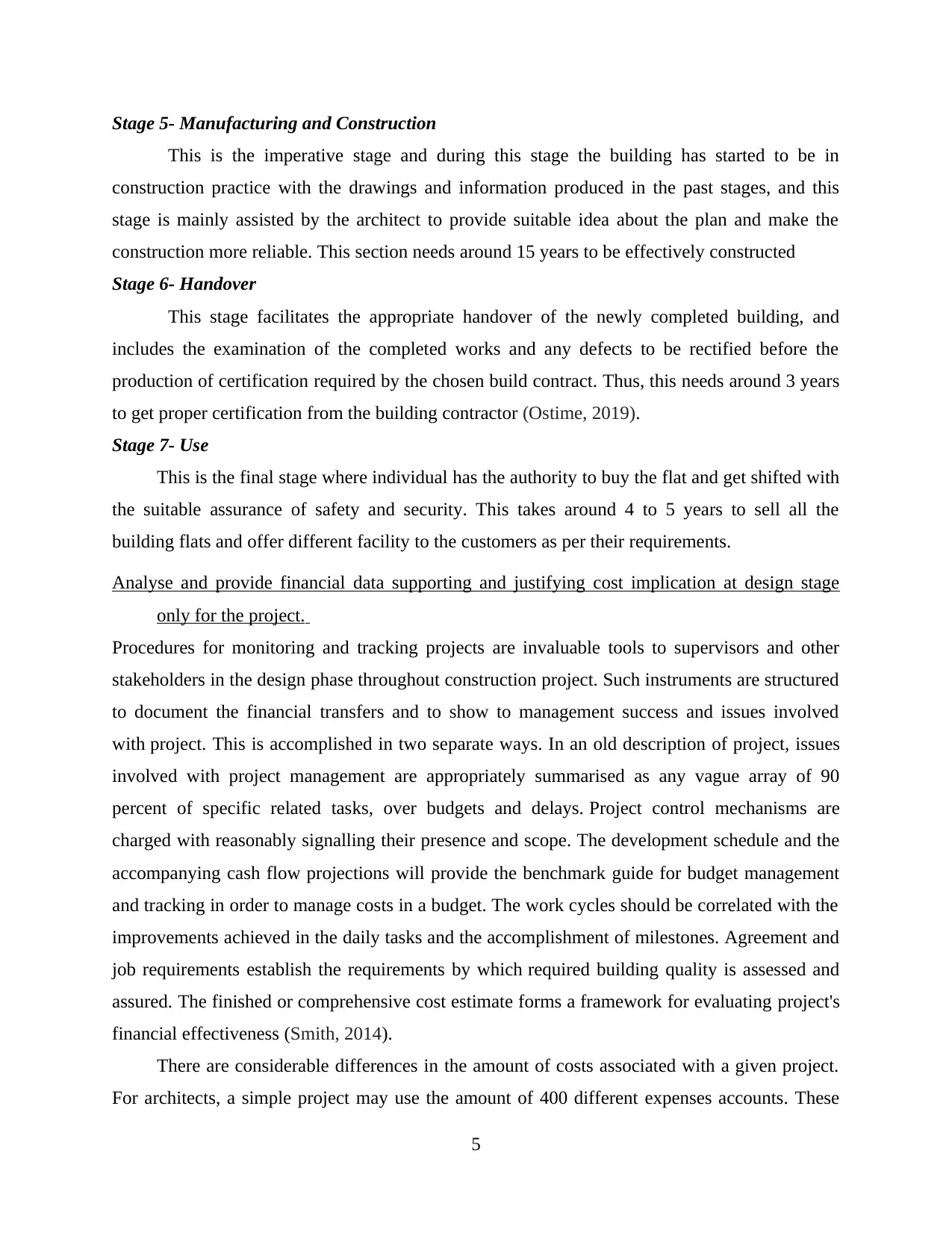
Stage 5- Manufacturing and Construction
This is the imperative stage and during this stage the building has started to be in
construction practice with the drawings and information produced in the past stages, and this
stage is mainly assisted by the architect to provide suitable idea about the plan and make the
construction more reliable. This section needs around 15 years to be effectively constructed
Stage 6- Handover
This stage facilitates the appropriate handover of the newly completed building, and
includes the examination of the completed works and any defects to be rectified before the
production of certification required by the chosen build contract. Thus, this needs around 3 years
to get proper certification from the building contractor (Ostime, 2019).
Stage 7- Use
This is the final stage where individual has the authority to buy the flat and get shifted with
the suitable assurance of safety and security. This takes around 4 to 5 years to sell all the
building flats and offer different facility to the customers as per their requirements.
Analyse and provide financial data supporting and justifying cost implication at design stage
only for the project.
Procedures for monitoring and tracking projects are invaluable tools to supervisors and other
stakeholders in the design phase throughout construction project. Such instruments are structured
to document the financial transfers and to show to management success and issues involved
with project. This is accomplished in two separate ways. In an old description of project, issues
involved with project management are appropriately summarised as any vague array of 90
percent of specific related tasks, over budgets and delays. Project control mechanisms are
charged with reasonably signalling their presence and scope. The development schedule and the
accompanying cash flow projections will provide the benchmark guide for budget management
and tracking in order to manage costs in a budget. The work cycles should be correlated with the
improvements achieved in the daily tasks and the accomplishment of milestones. Agreement and
job requirements establish the requirements by which required building quality is assessed and
assured. The finished or comprehensive cost estimate forms a framework for evaluating project's
financial effectiveness (Smith, 2014).
There are considerable differences in the amount of costs associated with a given project.
For architects, a simple project may use the amount of 400 different expenses accounts. These
5
This is the imperative stage and during this stage the building has started to be in
construction practice with the drawings and information produced in the past stages, and this
stage is mainly assisted by the architect to provide suitable idea about the plan and make the
construction more reliable. This section needs around 15 years to be effectively constructed
Stage 6- Handover
This stage facilitates the appropriate handover of the newly completed building, and
includes the examination of the completed works and any defects to be rectified before the
production of certification required by the chosen build contract. Thus, this needs around 3 years
to get proper certification from the building contractor (Ostime, 2019).
Stage 7- Use
This is the final stage where individual has the authority to buy the flat and get shifted with
the suitable assurance of safety and security. This takes around 4 to 5 years to sell all the
building flats and offer different facility to the customers as per their requirements.
Analyse and provide financial data supporting and justifying cost implication at design stage
only for the project.
Procedures for monitoring and tracking projects are invaluable tools to supervisors and other
stakeholders in the design phase throughout construction project. Such instruments are structured
to document the financial transfers and to show to management success and issues involved
with project. This is accomplished in two separate ways. In an old description of project, issues
involved with project management are appropriately summarised as any vague array of 90
percent of specific related tasks, over budgets and delays. Project control mechanisms are
charged with reasonably signalling their presence and scope. The development schedule and the
accompanying cash flow projections will provide the benchmark guide for budget management
and tracking in order to manage costs in a budget. The work cycles should be correlated with the
improvements achieved in the daily tasks and the accomplishment of milestones. Agreement and
job requirements establish the requirements by which required building quality is assessed and
assured. The finished or comprehensive cost estimate forms a framework for evaluating project's
financial effectiveness (Smith, 2014).
There are considerable differences in the amount of costs associated with a given project.
For architects, a simple project may use the amount of 400 different expenses accounts. These
5
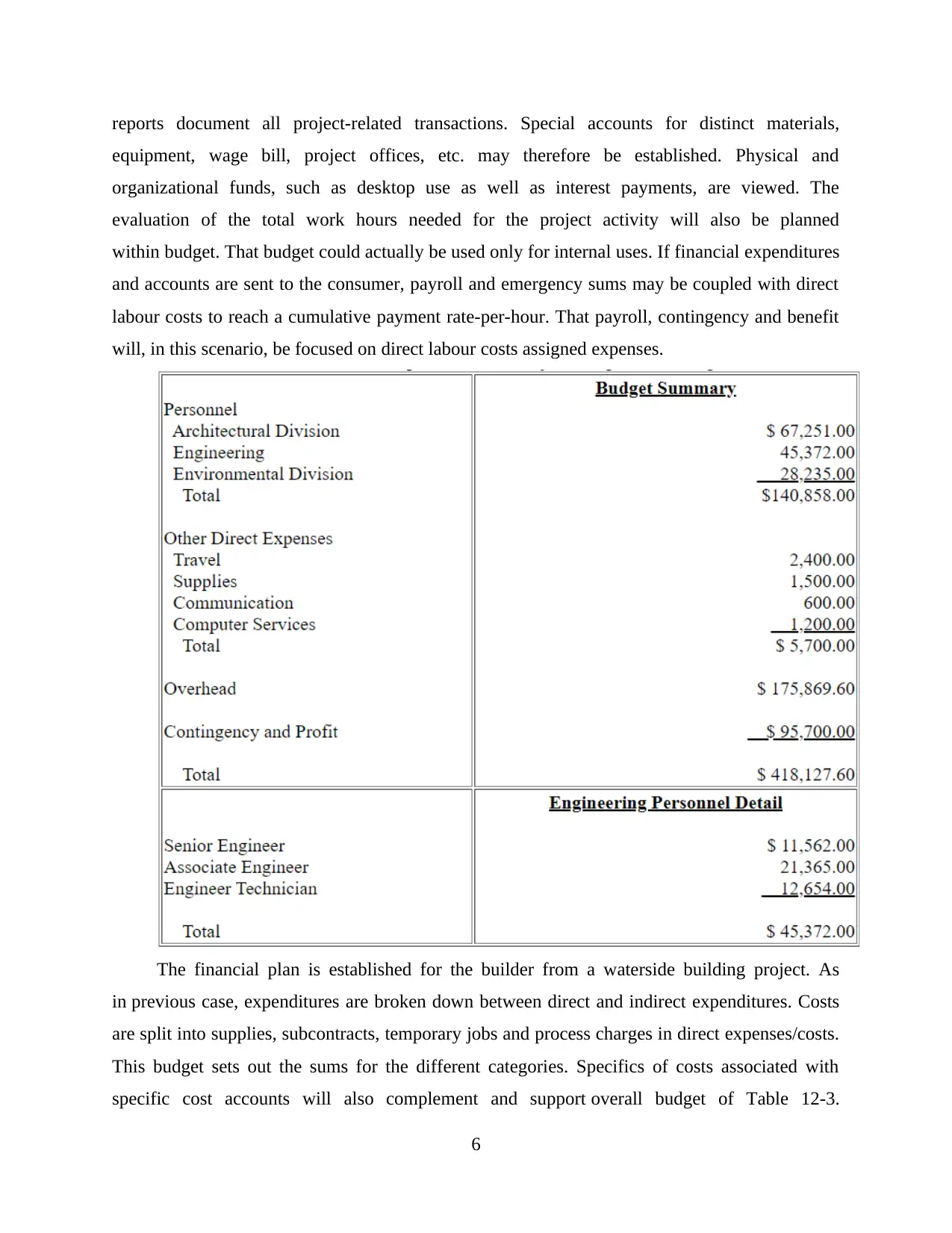
reports document all project-related transactions. Special accounts for distinct materials,
equipment, wage bill, project offices, etc. may therefore be established. Physical and
organizational funds, such as desktop use as well as interest payments, are viewed. The
evaluation of the total work hours needed for the project activity will also be planned
within budget. That budget could actually be used only for internal uses. If financial expenditures
and accounts are sent to the consumer, payroll and emergency sums may be coupled with direct
labour costs to reach a cumulative payment rate-per-hour. That payroll, contingency and benefit
will, in this scenario, be focused on direct labour costs assigned expenses.
The financial plan is established for the builder from a waterside building project. As
in previous case, expenditures are broken down between direct and indirect expenditures. Costs
are split into supplies, subcontracts, temporary jobs and process charges in direct expenses/costs.
This budget sets out the sums for the different categories. Specifics of costs associated with
specific cost accounts will also complement and support overall budget of Table 12-3.
6
equipment, wage bill, project offices, etc. may therefore be established. Physical and
organizational funds, such as desktop use as well as interest payments, are viewed. The
evaluation of the total work hours needed for the project activity will also be planned
within budget. That budget could actually be used only for internal uses. If financial expenditures
and accounts are sent to the consumer, payroll and emergency sums may be coupled with direct
labour costs to reach a cumulative payment rate-per-hour. That payroll, contingency and benefit
will, in this scenario, be focused on direct labour costs assigned expenses.
The financial plan is established for the builder from a waterside building project. As
in previous case, expenditures are broken down between direct and indirect expenditures. Costs
are split into supplies, subcontracts, temporary jobs and process charges in direct expenses/costs.
This budget sets out the sums for the different categories. Specifics of costs associated with
specific cost accounts will also complement and support overall budget of Table 12-3.
6
⊘ This is a preview!⊘
Do you want full access?
Subscribe today to unlock all pages.

Trusted by 1+ million students worldwide
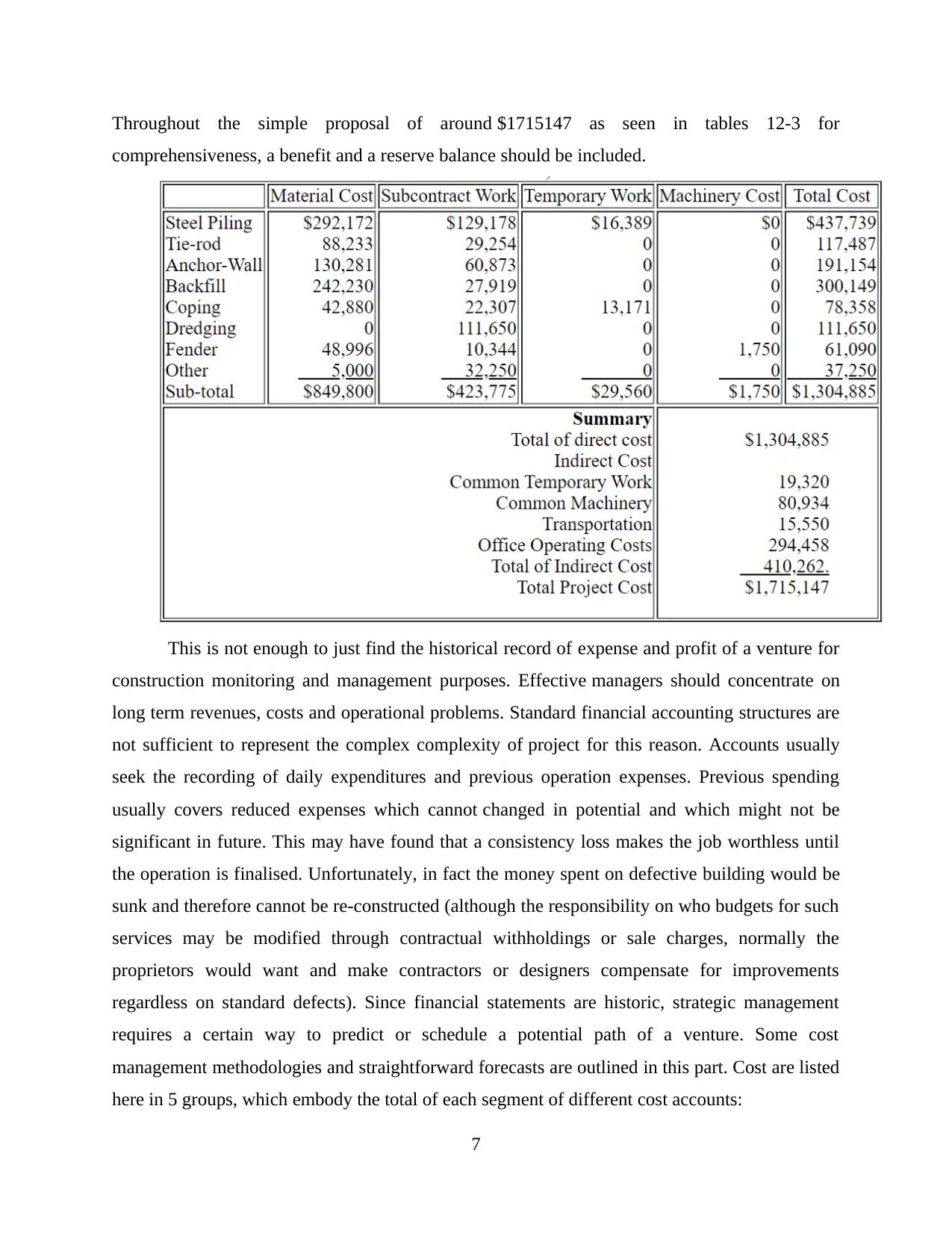
Throughout the simple proposal of around $1715147 as seen in tables 12-3 for
comprehensiveness, a benefit and a reserve balance should be included.
This is not enough to just find the historical record of expense and profit of a venture for
construction monitoring and management purposes. Effective managers should concentrate on
long term revenues, costs and operational problems. Standard financial accounting structures are
not sufficient to represent the complex complexity of project for this reason. Accounts usually
seek the recording of daily expenditures and previous operation expenses. Previous spending
usually covers reduced expenses which cannot changed in potential and which might not be
significant in future. This may have found that a consistency loss makes the job worthless until
the operation is finalised. Unfortunately, in fact the money spent on defective building would be
sunk and therefore cannot be re-constructed (although the responsibility on who budgets for such
services may be modified through contractual withholdings or sale charges, normally the
proprietors would want and make contractors or designers compensate for improvements
regardless on standard defects). Since financial statements are historic, strategic management
requires a certain way to predict or schedule a potential path of a venture. Some cost
management methodologies and straightforward forecasts are outlined in this part. Cost are listed
here in 5 groups, which embody the total of each segment of different cost accounts:
7
comprehensiveness, a benefit and a reserve balance should be included.
This is not enough to just find the historical record of expense and profit of a venture for
construction monitoring and management purposes. Effective managers should concentrate on
long term revenues, costs and operational problems. Standard financial accounting structures are
not sufficient to represent the complex complexity of project for this reason. Accounts usually
seek the recording of daily expenditures and previous operation expenses. Previous spending
usually covers reduced expenses which cannot changed in potential and which might not be
significant in future. This may have found that a consistency loss makes the job worthless until
the operation is finalised. Unfortunately, in fact the money spent on defective building would be
sunk and therefore cannot be re-constructed (although the responsibility on who budgets for such
services may be modified through contractual withholdings or sale charges, normally the
proprietors would want and make contractors or designers compensate for improvements
regardless on standard defects). Since financial statements are historic, strategic management
requires a certain way to predict or schedule a potential path of a venture. Some cost
management methodologies and straightforward forecasts are outlined in this part. Cost are listed
here in 5 groups, which embody the total of each segment of different cost accounts:
7
Paraphrase This Document
Need a fresh take? Get an instant paraphrase of this document with our AI Paraphraser
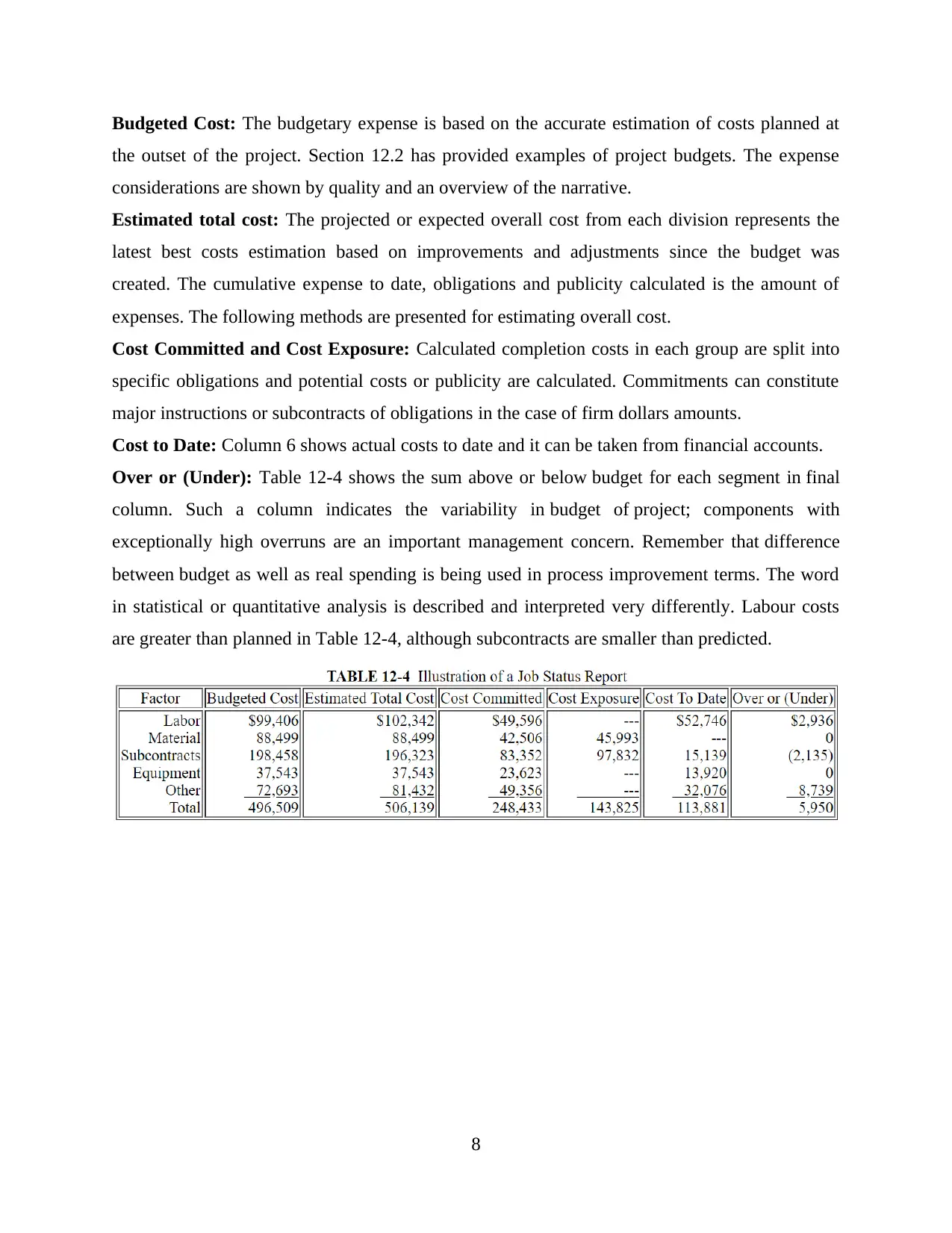
Budgeted Cost: The budgetary expense is based on the accurate estimation of costs planned at
the outset of the project. Section 12.2 has provided examples of project budgets. The expense
considerations are shown by quality and an overview of the narrative.
Estimated total cost: The projected or expected overall cost from each division represents the
latest best costs estimation based on improvements and adjustments since the budget was
created. The cumulative expense to date, obligations and publicity calculated is the amount of
expenses. The following methods are presented for estimating overall cost.
Cost Committed and Cost Exposure: Calculated completion costs in each group are split into
specific obligations and potential costs or publicity are calculated. Commitments can constitute
major instructions or subcontracts of obligations in the case of firm dollars amounts.
Cost to Date: Column 6 shows actual costs to date and it can be taken from financial accounts.
Over or (Under): Table 12-4 shows the sum above or below budget for each segment in final
column. Such a column indicates the variability in budget of project; components with
exceptionally high overruns are an important management concern. Remember that difference
between budget as well as real spending is being used in process improvement terms. The word
in statistical or quantitative analysis is described and interpreted very differently. Labour costs
are greater than planned in Table 12-4, although subcontracts are smaller than predicted.
8
the outset of the project. Section 12.2 has provided examples of project budgets. The expense
considerations are shown by quality and an overview of the narrative.
Estimated total cost: The projected or expected overall cost from each division represents the
latest best costs estimation based on improvements and adjustments since the budget was
created. The cumulative expense to date, obligations and publicity calculated is the amount of
expenses. The following methods are presented for estimating overall cost.
Cost Committed and Cost Exposure: Calculated completion costs in each group are split into
specific obligations and potential costs or publicity are calculated. Commitments can constitute
major instructions or subcontracts of obligations in the case of firm dollars amounts.
Cost to Date: Column 6 shows actual costs to date and it can be taken from financial accounts.
Over or (Under): Table 12-4 shows the sum above or below budget for each segment in final
column. Such a column indicates the variability in budget of project; components with
exceptionally high overruns are an important management concern. Remember that difference
between budget as well as real spending is being used in process improvement terms. The word
in statistical or quantitative analysis is described and interpreted very differently. Labour costs
are greater than planned in Table 12-4, although subcontracts are smaller than predicted.
8
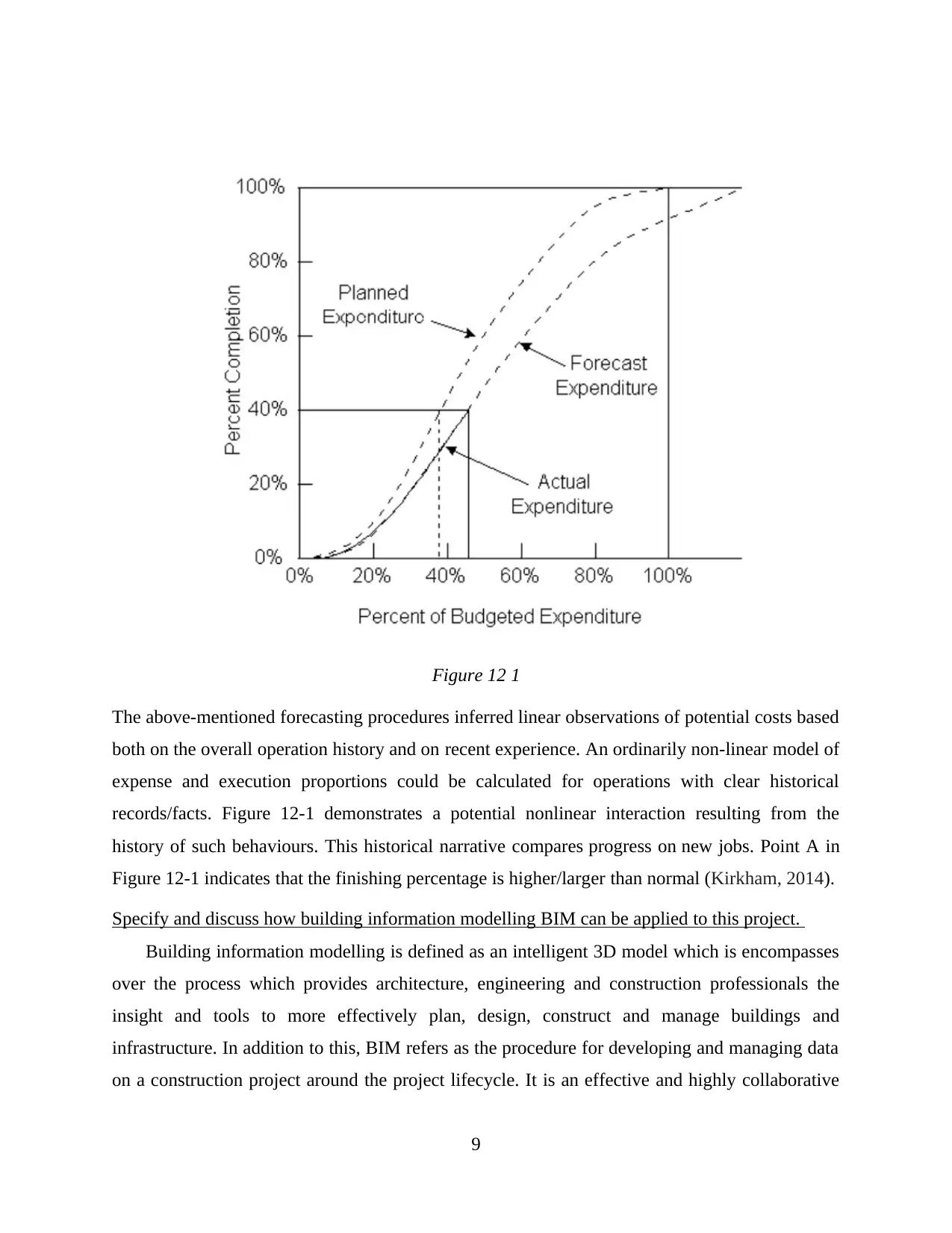
Figure 12 1
The above-mentioned forecasting procedures inferred linear observations of potential costs based
both on the overall operation history and on recent experience. An ordinarily non-linear model of
expense and execution proportions could be calculated for operations with clear historical
records/facts. Figure 12-1 demonstrates a potential nonlinear interaction resulting from the
history of such behaviours. This historical narrative compares progress on new jobs. Point A in
Figure 12-1 indicates that the finishing percentage is higher/larger than normal (Kirkham, 2014).
Specify and discuss how building information modelling BIM can be applied to this project.
Building information modelling is defined as an intelligent 3D model which is encompasses
over the process which provides architecture, engineering and construction professionals the
insight and tools to more effectively plan, design, construct and manage buildings and
infrastructure. In addition to this, BIM refers as the procedure for developing and managing data
on a construction project around the project lifecycle. It is an effective and highly collaborative
9
The above-mentioned forecasting procedures inferred linear observations of potential costs based
both on the overall operation history and on recent experience. An ordinarily non-linear model of
expense and execution proportions could be calculated for operations with clear historical
records/facts. Figure 12-1 demonstrates a potential nonlinear interaction resulting from the
history of such behaviours. This historical narrative compares progress on new jobs. Point A in
Figure 12-1 indicates that the finishing percentage is higher/larger than normal (Kirkham, 2014).
Specify and discuss how building information modelling BIM can be applied to this project.
Building information modelling is defined as an intelligent 3D model which is encompasses
over the process which provides architecture, engineering and construction professionals the
insight and tools to more effectively plan, design, construct and manage buildings and
infrastructure. In addition to this, BIM refers as the procedure for developing and managing data
on a construction project around the project lifecycle. It is an effective and highly collaborative
9
⊘ This is a preview!⊘
Do you want full access?
Subscribe today to unlock all pages.

Trusted by 1+ million students worldwide
1 out of 15
Related Documents
Your All-in-One AI-Powered Toolkit for Academic Success.
+13062052269
info@desklib.com
Available 24*7 on WhatsApp / Email
![[object Object]](/_next/static/media/star-bottom.7253800d.svg)
Unlock your academic potential
Copyright © 2020–2025 A2Z Services. All Rights Reserved. Developed and managed by ZUCOL.





